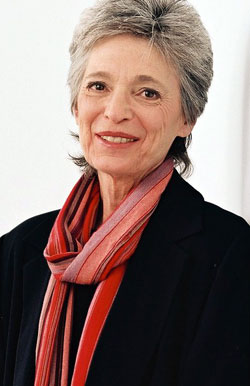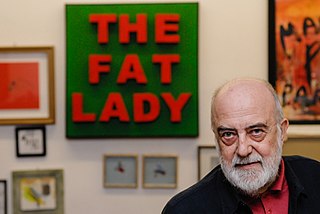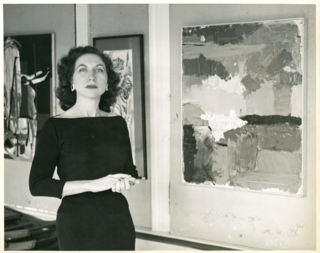Related Research Articles

Wifredo Óscar de la Concepción Lam y Castilla, better known as Wifredo Lam, was a Cuban artist who sought to portray and revive the enduring Afro-Cuban spirit and culture. Inspired by and in contact with some of the most renowned artists of the 20th century, including Pablo Picasso, Henri Matisse, Frida Kahlo and Diego Rivera, Lam melded his influences and created a unique style, which was ultimately characterized by the prominence of hybrid figures. This distinctive visual style of his also influences many artists. Though he was predominantly a painter, he also worked with sculpture, ceramics and printmaking in his later life.

Dorothea Margaret Tanning was an American painter, printmaker, sculptor, writer, and poet. Her early work was influenced by Surrealism.
Museums of modern art listed alphabetically by country.

Augusto de Campos is a Brazilian writer who was a founder of the Concrete poetry movement in Brazil. He is also a translator, music critic and visual artist.

Pierre Bismuth is a French artist and filmmaker based in Brussels. His practice can be placed in the tradition of conceptual art and appropriation art. His work uses a variety of media and materials, including painting, sculpture, collage, video, architecture, performance, music, and film. He is best known for being among the authors of the story for Eternal Sunshine of the Spotless Mind (2004), for which he won the Academy Award for Best Original Screenplay alongside Michel Gondry and Charlie Kaufman. Bismuth made his directorial debut with the 2016 feature film Where is Rocky II?.

Lynne Cohen was an American-Canadian photographer.

Mirella Bentivoglio was an Italian sculptor, poet, performance artist and curator.
Caterina Davinio is an Italian poet, novelist and new media artist. She is the author of works of digital art, net.art, video art and was the creator of Italian Net-poetry in 1998.
Eugenio Miccini was an Italian artist and writer, considered to be one of the fathers of Italian visual poetry.

Alice Phillipot (Alice Rahon) (8 June 1904 – September 1987) was a French-born Mexican poet and artist whose work contributed to the beginning of abstract expression in Mexico. She began as a surrealist poet in Europe but began painting in Mexico. She was a prolific artist from the late 1940s to the 1960s, exhibiting frequently in Mexico and the United States, with a wide circle of friends in these two countries. Her work remained tied to surrealism but was also innovative, including abstract elements and the use of techniques such as sgraffito and the use of sand for texture. She became isolated in her later life due to health issues.
Mark Lewis is a Canadian artist, best known for his film installations. He represented Canada at the 2009 Venice Biennale.

Rafael Navarro Garralaga is a Spanish art photographer.

Hans Op de Beeck is a Belgian visual artist who lives and works in Brussels. For over twenty years he has exhibiting internationally.
Gustavo Arias Murueta was a Mexican painter, sculptor and poet, a member of the Salón de la Plástica Mexicana best known for his work in drawing, graphic arts and oil painting. He originally studied architecture at the Universidad Nacional Autónoma de México where he met artists such as Rufino Tamayo, David Alfaro Siqueiros and José Clemente Orozco. In the 1950s, he began to produce artworks, with his first exhibition in 1961. From then until his death he had a career as an artist with individual and collective exhibitions in both Mexico and abroad. While his work had been heavily influenced by Orozco, he was considered part of the Generación de la Ruptura movement.

Giovanni Fontana is an Italian poet, performance artist, author and publisher.

Ugo Carrega was an Italian artist and poet. Carrega was one of the main exponents of visual poetry, although he preferred the term "New Writing", an experimental form of writing that combines signs of different extraction. Carrega was active mainly in Milan, where he founded the cultural centers Centro Suolo (1969), Centro Tool (1971), Mercato del Sale (1974) and Euforia Costante (1993). He also founded and directed the art magazines Tool (1965), Bollettino Tool (1968), aaa (1969) and Bollettino da dentro (1972).
Barry X Ball is an American sculptor who lives and works in New York City.

The Archivio di Nuova Scrittura is a cultural association founded in 1988 in Milan, Italy by art collector Paolo Della Grazia. The archive preserves a large artistic and documentary heritage about any form of artistic expression featuring the use of both the word and the sign. Born from the encounter between Della Grazia and artist Ugo Carrega, in the 1990s the ANS became the main Italian research center on visual poetry, organizing exhibitions, meetings and other cultural events. In 1998 the Archivio di Nuova Scrittura was deposited in part at the Mart in Rovereto and in part at the Museion in Bozen. The artwork section of the ANS includes about 1,600 works by international artists at Mart and about 2,000 at Museion. The ANS archives preserve, apart from the internal archive of the association, the Fraccaro-Carrega fonds, containing the papers of collector Marco Fraccaro and visual poet Ugo Carrega. The library section, preserved at Mart, contains more than 18,000 volumes, among them 600 artist's books and hundreds of futurist first editions, and 600 art magazines including about 300 international artist's magazines.

Nela Arias-Misson was a Cuban-born abstract expressionist painter and sculptor. Nela Arias-Misson was a contemporary and friend of the 20th-century painters Mark Rothko, Willem de Kooning, Franz Kline, Robert Motherwell, Karel Appel, Walasse Ting, and Antoni Tapies. She exhibited internationally and was connected to many established figures in the art world throughout her life. Her art synthesizes her experiences as an ahead-of-her-time, determined, female artist, linking abstract expressionism in Cuba, the United States, and Europe.
Tina Escaja, also known as Alm@ Pérez, is a Spanish-American writer, activist, feminist scholar and digital artist based in Burlington, Vermont. She is a Distinguished Professor of Romance Languages and Gender & Women's Studies, and the Director of the Gender, Sexuality and Women's Studies Program at the University of Vermont. She is the winner of the International Poetry Prize Dulce María Loynaz, and the National Latino Poetry Award for Young Adults, Isabel Campoy-Alma Flor Ada. She is considered a pioneer in the field of electronic literature in Spanish. She is a full member of the North American Academy of the Spanish Language (ANLE), and Corresponding member of the Royal Spanish Academy (RAE).
References
- ↑ In: De Gruyter (Ed.): AKL Online General Artist Lexicon Online / Artists of the World Online . De Gruyter, 2009
- ↑ "Alain Arias-Misson". beinecke. Retrieved February 7, 2024.
- ↑ "Buscador - General | MACBA Museum of Contemporary Art of Barcelona". www.macba.cat. Retrieved February 7, 2024.
- ↑ "The Emily Harvey Foundation". www.emilyharveyfoundation.org. Retrieved February 7, 2024.
- ↑ Jan de Vree: "Even where we don't live, we are at home!" In: Ediciones Asimétricas (ed.): . Madrid 2019, ISBN 978-84-949798-0-4 , p. 68–73
- ↑ Ediciones Asimétricas (ed.): Public Poems. 50 years of writing on the street . Madrid 2019, ISBN 978-84-949798-0-4
- ↑ Tom Edmonds: Positions. In: Astropoems and Vertical Group Exercises. Chelsea College of Arts, 2018, accessed June 23, 2023 (English).
- ↑ Alain Arias-Misson: El autor... casi. In: Galeria Estampa. Galeria Estampa, accessed on June 23, 2023 (English).
- ↑ Alain Arias-Misson: . Ed.: Factotum Art Edition. Calaone-Baone 1978.
- ↑ Alain Arias-Misson: The Punctuation Public Poem. In: YouTube. 1972, accessed June 30, 2023
- ↑ Alain Arias-Misson: The Proust Public Poem. In: YouTube. 1988, accessed June 30, 2023 .
- ↑ Alain Arias-Misson: The Public Shamanic Chapel Sistine Public Poem. In: YouTube. 1998, accessed June 30, 2023 .
- ↑ Alain Arias-Misson: The Surveillance Public Poem. In: YouTube. 2003, accessed June 30, 2023 .
- ↑ Alain Arias-Misson: The Gan(t)d Public Panties Public Poem. In: YouTube. 2007, accessed June 30, 2023 .
- ↑ Alain Arias-Misson: La Derniere S(c)ene Public Poem. 2008, accessed June 30, 2023 .
- ↑ Alain Arias-Misson: The Last Supper Public Poem. In: YouTube. 2009, accessed June 30, 2023 .
- ↑ Alain Arias-Misson: The Public Linguistic Poem of Antwerp. In: YouTube. 2013, accessed June 30, 2023 .
- ↑ Alain Arias-Misson: The Public Sinking of Venice Poem. In: YouTube. 2015, accessed June 30, 2023 .
- ↑ Alain Arias-Misson: The Burkini Public Poem. In: YouTube. 2017, accessed June 30, 2023 .
- ↑ Alain Arias-Misson: The Urbanographies Public Poem. In: YouTube. 2019, accessed June 30, 2023 .
- ↑ Alain Arias-Misson: The Illuminaciones Public Poem. In: YouTube. 2019, accessed June 30, 2023 .
- ↑ Alain Arias-Misson: The Public Silence Poem. In: YouTube. 2020, accessed June 30, 2023 .
- ↑ Alain Arias-Misson: The Public BOEM Poem. In: YouTube. 2021, accessed on June 30, 2023 .
- ↑ Alain Arias-Misson: . Trafford Publishing, 2007, ISBN 978-1-4251-0278-4 , p. 50-55 .
- ↑ Alain Arias-Misson: Speechless - speaking with the dead. In: YouTube. 2012, accessed on June 23, 2023 (English).
- ↑ Alain Arias-Misson: Ocean of Eros, Gulls of Contemplation. In: YouTube. 2015, accessed on June 23, 2023 (English).
- ↑ Alain Arias-Misson: Mecanoman. In: YouTube. 2017, accessed on June 23, 2023 (English).
- ↑ Williams, Emmett (1967). An Anthology of Concrete Poetry. Something Else Press.
- ↑ Bory, Jean-François (1967). Bientôt. Contexte Production.
- ↑ Bory, Jean-François (1968). Once Again. New York: New Directions.
- ↑ Mostra de Poesia Concreta, Venice, Italy: Stamperia di Venezia, 1969, retrieved October 13, 2023
- ↑ Klankteksten – Konkrete Poëzie – Visuele Teksten, Amsterdam: Stedelijk Museum, 1971
- ↑ Buchstäblich wörtlich, wörtlich buchstäblich, Berlin, Germany: Staatl. Museen Preuss. Kulturbesitz, 1987
- ↑ Poésure et Peintrie - d'un art, l'autre, Paris, France: Réunion des musées nationaux, 1993, retrieved October 13, 2023
- ↑ La parola nell'arte: ricerche d'avanguardia nel '900 dal futurismo a oggi attraverso le collezioni del Mart, Milano, Italy: Skira, 2007
- ↑ "Prix international de littérature Bernard Heidsieck–Centre Pompidou - Centre Pompidou". Centre Pompidou . Retrieved October 13, 2023.
- ↑ Alain Aris-Misson. In: Postwar Culture. Beinecke Rare Book & Manuscript Library, accessed on July 7, 2023 (English).
- ↑ Sackner Archives. In: IOWA University Libraries. Retrieved July 7, 2023 (English). https://aspace.lib.uiowa.edu/agents/people/7279
- ↑ Alain Arias Misson. In: Museu d'Art Contemporani Barcelona. Museu d'Art Contemporani Barcelona, accessed on June 23, 2023 (English).
- ↑ Sound Poetry. Alain Arias-Misson. Correspondence 1985-1989; biography., Folder 36, Box: 93, Folder: 36. Dick Higgins Archive, MS132. Charles Deering McCormick Library of Special Collections. https://findingaids.library.northwestern.edu/repositories/7/archival_objects/253194 Accessed February 08, 2024.
- ↑ Alain Arias Misson. In: Fondazione Bonotto. Retrieved June 23, 2023 (English).
- ↑ Alain Arias Misson. In: Archivo Conz. Retrieved June 23, 2023 (English)
- ↑ Alain Arias Misson. In: Anita and Günter Lichtenstein Foundation. Anita and Günter Lichtenstein Foundation, accessed on June 23, 2023 (English).